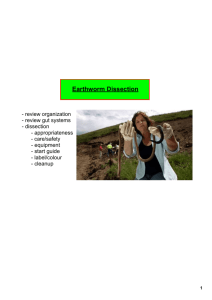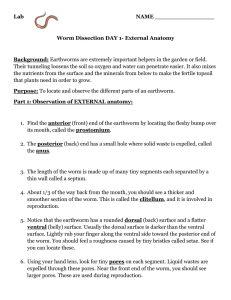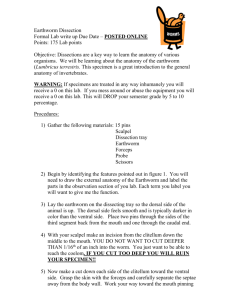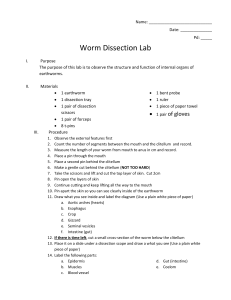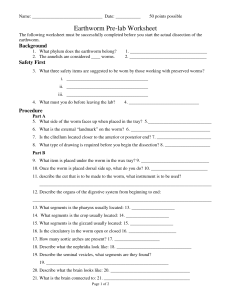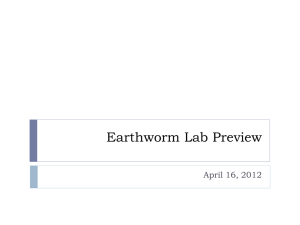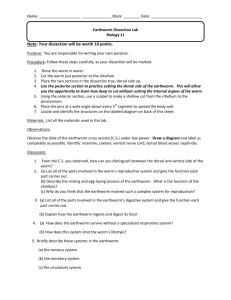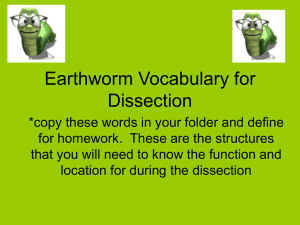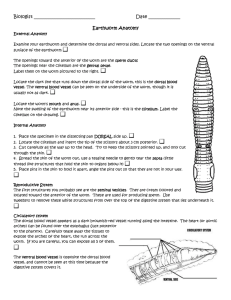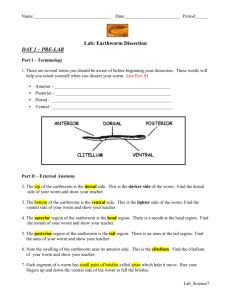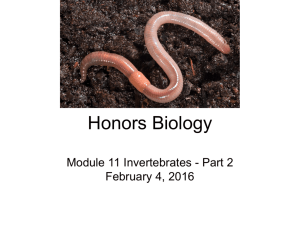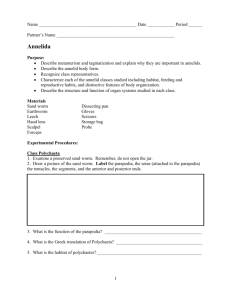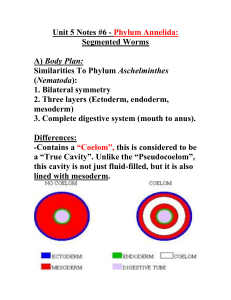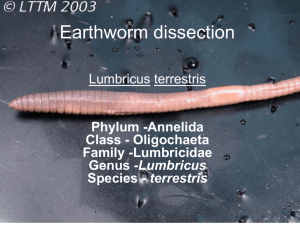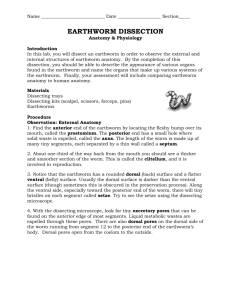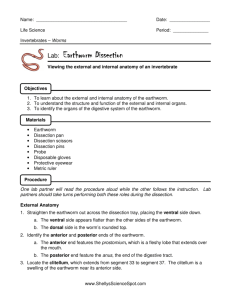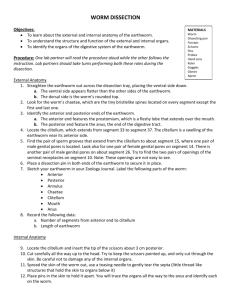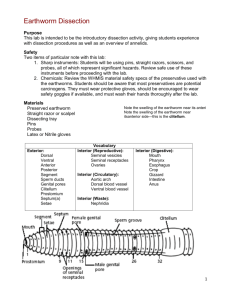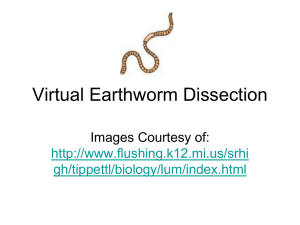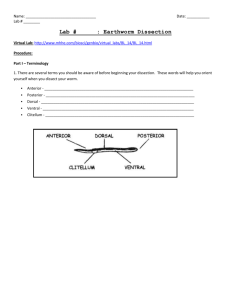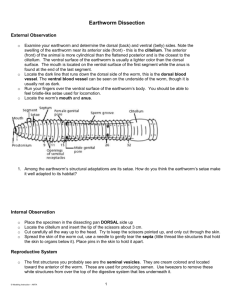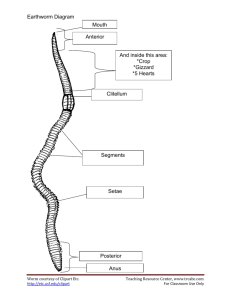EARTHWORM DISSECTION
advertisement
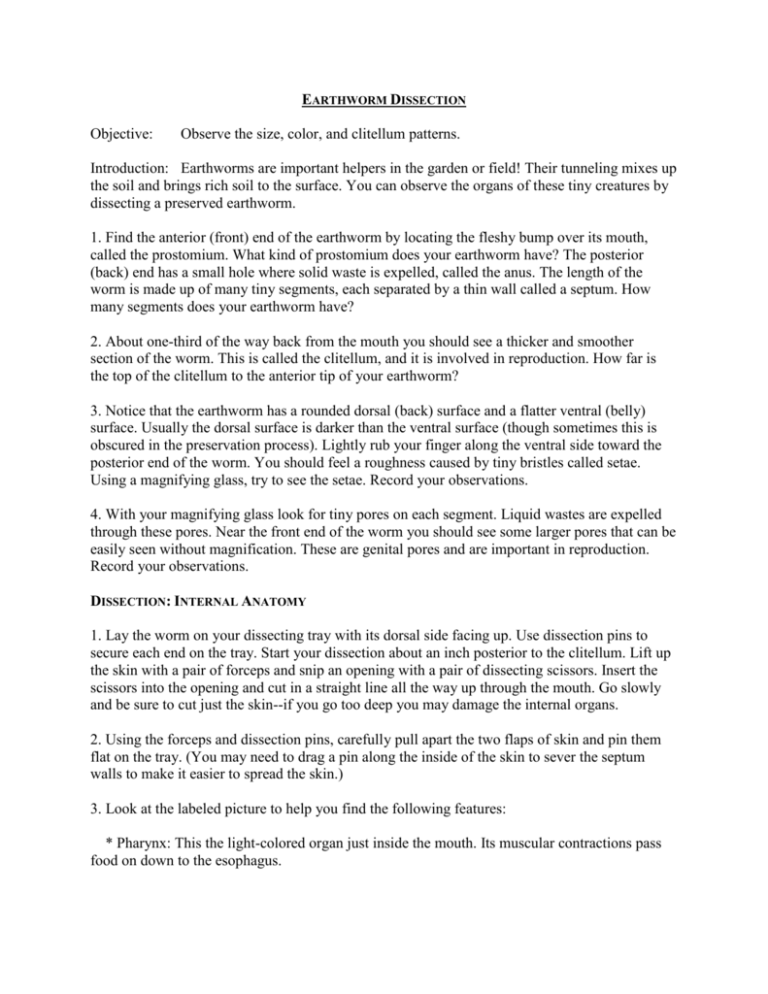
EARTHWORM DISSECTION Objective: Observe the size, color, and clitellum patterns. Introduction: Earthworms are important helpers in the garden or field! Their tunneling mixes up the soil and brings rich soil to the surface. You can observe the organs of these tiny creatures by dissecting a preserved earthworm. 1. Find the anterior (front) end of the earthworm by locating the fleshy bump over its mouth, called the prostomium. What kind of prostomium does your earthworm have? The posterior (back) end has a small hole where solid waste is expelled, called the anus. The length of the worm is made up of many tiny segments, each separated by a thin wall called a septum. How many segments does your earthworm have? 2. About one-third of the way back from the mouth you should see a thicker and smoother section of the worm. This is called the clitellum, and it is involved in reproduction. How far is the top of the clitellum to the anterior tip of your earthworm? 3. Notice that the earthworm has a rounded dorsal (back) surface and a flatter ventral (belly) surface. Usually the dorsal surface is darker than the ventral surface (though sometimes this is obscured in the preservation process). Lightly rub your finger along the ventral side toward the posterior end of the worm. You should feel a roughness caused by tiny bristles called setae. Using a magnifying glass, try to see the setae. Record your observations. 4. With your magnifying glass look for tiny pores on each segment. Liquid wastes are expelled through these pores. Near the front end of the worm you should see some larger pores that can be easily seen without magnification. These are genital pores and are important in reproduction. Record your observations. DISSECTION: INTERNAL ANATOMY 1. Lay the worm on your dissecting tray with its dorsal side facing up. Use dissection pins to secure each end on the tray. Start your dissection about an inch posterior to the clitellum. Lift up the skin with a pair of forceps and snip an opening with a pair of dissecting scissors. Insert the scissors into the opening and cut in a straight line all the way up through the mouth. Go slowly and be sure to cut just the skin--if you go too deep you may damage the internal organs. 2. Using the forceps and dissection pins, carefully pull apart the two flaps of skin and pin them flat on the tray. (You may need to drag a pin along the inside of the skin to sever the septum walls to make it easier to spread the skin.) 3. Look at the labeled picture to help you find the following features: * Pharynx: This the light-colored organ just inside the mouth. Its muscular contractions pass food on down to the esophagus. * Hearts (or "aortic arches"): Behind the pharynx are five dark loops wrapped around the esophagus. These are the blood vessels that serve as the hearts of the worm. * Dorsal blood vessel: This is a dark line extending from the hearts over the top of the crop. * Crop: Food from the esophagus is temporarily stored in the crop. * Gizzard: Food comes from the crop into the gizzard, where it is ground up. * Intestine: The intestine is the long tube extending from the gizzard all the way to the anus. Food is digested and absorbed here. * Reproductive organs: The light colored tissue above and around the hearts are seminal vesicles. Other reproductive parts appear as small white organs on the ventral side of the hearts. * Ventral Nerve Cord: With your forceps, gently push aside the intestine to view the long white nerve cord running along the length of the worm beneath it. 4. Optional: Finish cutting the rest of the worm open from the first incision through to the anus. Observe how the intestine and ventral nerve cord both continue through the entire length of the worm. Data (done in your notebook) Throughout the dissection, record your observations. Number of segments _________ Measurement (cm) Anterior to posterior Anterior to clitellum Clitellum to posterior Sketch – (must include labels and detail) – and record your observations about each one. a. Prostomium (5 cm segment) b. the whole external earthworm (exact measurement) c. clitellum (5 cm segment) d. internal anatomy of upper dorsal e. internal anatomy of whole earthworm
